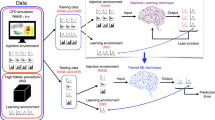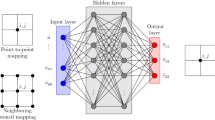Abstract
Machine learning (ML) techniques for turbulence modeling are becoming an important tool to build the bridge between low-cost-low-accurate turbulence models (like RANS) and high-cost-high-accurate procedures to represent turbulence (like DNS). In recent studies, however, it was observed that the DNS data for the Reynolds stress tensor (RST) do not satisfactorily recover the mean velocity field. This fact has two rooting sources, the lack of convergence of statistical fields, and the ill-conditioning of the RANS equations. To address these two aspects, we employ two remedies in the turbulent flow through a square duct (SD). On the one side, we applied symmetry filters on the flow data to provide more converged statistical quantities. On the other side, we contrast the traditional approach where the model target is the Reynolds stress tensor with a recent approach where the Reynolds force vector (RFV) is the target. We also provide a comparison between two ML techniques commonly used in the literature, neural network and random forest, in an invariant formulation recently proposed. The results have shown that there is a direct relation between the convergence of DNS data and the performance of data-driven turbulence models. The models obtained from symmetrical data presented lower error propagation to the mean velocity field. The Reynolds force vector is shown to be a target that can produce more accurate results, corroborating recent findings of the literature. The performance of the two ML techniques was equivalent, with small differences depending on the target quantity (RST or RFV) and the velocity component considered (main flow or secondary flow).



























Similar content being viewed by others
References
Ling, J., Jones, R., Templeton, J.: Machine learning strategies for systems with invariance properties. J. Comput. Phys. 318, 22 (2016)
Ling, J., Kurzawski, A., Templeton, J.: Reynolds averaged turbulence modelling using deep neural networks with embedded invariance. J. Fluid Mech. 807, 155 (2016)
Wu, J.L., Xiao, H., Paterson, E.: Physics-informed machine learning approach for augmenting turbulence models: a comprehensive framework. Phys. Rev. Fluids 3(074602), 1 (2018)
Geneva, N., Zabaras, N.: Quantifying model form uncertainty in Reynolds-averaged turbulence models with Bayesian deep neural networks. J. Comput. Phys. 383, 125 (2019)
Wang, J.X., Huang, J., Duan, L., Xiao, H.: Prediction of Reynolds stresses in high-Mach-number turbulent boundary layers using physics-informed machine learning. Theoret. Comput. Fluid Dyn. 33, 1 (2019)
Cruz, M.A., Thompson, R.L., Sampaio, L.E.B., Bacchi, R.D.A.: The use of the Reynolds force vector in a physics informed machine learning approach for predictive turbulence modeling. Comput. Fluids 192, 1 (2019)
Kaandorp, M.L.A., Dwight, R.P.: Data-driven modelling of the Reynolds stress tensor using random forests with invariance. Comput. Fluids 202(104497), 1 (2020)
Modesti, D.: A priori tests of eddy viscosity models in square duct flow. Theoret. Comput. Fluid Dyn. 34, 713 (2020)
Zhao, Y., Akolekar, H.D., Weatheritt, J., Michelassi, V., Sandberg, R.D.: RANS turbulence model development using CFD-driven machine learning. J. Comput. Phys. 411, 109413 (2020)
Font, B., Weymouth, G.D., Nguyen, V.T., Tutty, O.R.: Deep learning of the spanwise-averaged Navier–Stokes equations. J. Comput. Phys. 434, 115 (2021)
Duraisamy, K., Iaccarino, G., Xiao, H.: Turbulence modeling in the age of data. Ann. Rev. Fluid Mech. 51, 357 (2019)
Jiang, C., Vinuesa, R., Chen, R., Mi, J., Laima, S., Li, H.: An interpretable framework of data-driven turbulence modeling using deep neural networks. Phys. Fluids 33(055133), 1 (2021)
Duraisamy, K.: Perspectives on machine learning-augmented Reynolds-averaged and large Eddy simulation models of turbulence. Phys. Rev. Fluids 6, 050504 (2021)
Thompson, R.L., Sampaio, L.E.B., Alves, F.A.V.B., Thais, L., Mompean, G.: A methodology to evaluate statistical errors in DNS data of plane channel flows. Comput Fluids 130, 1 (2016)
Poroseva, S., Colmenares, J., Murman, S.: On the accuracy of RANS simulations with DNS data. Phys. Fluids 28(115102), 1 (2016)
Wang, J.X., Xiao, H., Wu, J.L.: Physics informed machine learning approach for reconstructing Reynolds stress modeling discrepancies based on DNS data. Phys. Rev. Fluids 2, 034603 (2017)
Wu, J.L., Xiao, H., Sun, R., Wang, Q.: Reynolds-average Navier–Stokes equations with explicit data-driven Reynolds stress closure can be ill-conditioned. J. Fluid Mech. 869, 553 (2019)
Brener, B.P., Cruz, M.A., Thompson, R.L., Anjos, R.P.: An invariant and highly-accurate strategy for physics-informed machine learning turbulence modelling. J. Fluid Mech. 915(A110), 1 (2021)
Vreman, A.W., Kuerten, J.G.M.: Comparison of direct numerical simulation databases of turbulent channel flow at \(\text{ Re}_{\tau }=180\). Phys. Fluids 26, 015102 (2014)
Vreman, A.W., Kuerten, J.G.M.: Statistics of spatial derivatives of velocity and pressure in turbulent channel flow. Phys. Fluids 26, 085103 (2014)
Klewicki, J.C.: Properties of turbulent channel flow similarity solutions. J. Fluid Mech. 915(A39), (2021)
Andrade, J., Martins, R., Thompson, R., Mompean, G., Neto, A.: Analysis of uncertainties and convergence of turbulent wall-bounded flows by means of a physically-based criterion. Phys. Fluids 30, 045106 (2018)
Vinuesa, R., Prus, C., Schlatter, P., Nagib, H.: Convergence of numerical simulations of turbulent wall-bounded flows and mean cross-flow structure of rectangular ducts. Meccanica 51, 3025 (2016)
Flageul, C., Tiselj, I.: Convergence rate of individual and global quantities in direct numerical simulations. Phys. Fluids 30(111704), 1 (2018)
Oder, J., Flageul, C., Tiselj, I.: Statistical uncertainty of DNS in geometries without homogeneous directions. Appl. Sci. 11(1399), 1 (2021)
Pinelli, A., Uhlmann, M., Sekimoto, A., Kawahara, G.: Reynolds number dependence of mean flow structure in square duct turbulence. J. Fluid Mech. 644, 107 (2010)
Brener, B.P., Cruz, M.A., Macedo, M.S.S., Thompson, R.L.: An invariant and highly-accurate strategy for physics-informed machine learning turbulence modelling, submitted (2021)
Muck, K.C., Hoffmann, P.H., Bradshaw, P.: The effect of convex surface curvature on turbulent boundary layers. J. Fluid Mech. 161(1), 347 (1985)
Launder, B., Spalding, D.: The numerical computation of turbulent flow computer methods. Comput. Methods Appl. Mech. Eng. 3, 269 (1974)
Thompson, R.L., de Souza Mendes, P.R.: Persistence of straining and flow classification. Int. J. Eng. Sci. 43, 79 (2005)
Thompson, R.L.: Some perspectives on the dynamic history of a material element. Int. J. Eng. Sci. 46, 224 (2008)
Pedregosa, F., Varoquaux, G., Gramfort, A., Michel, V., Thirion, B., Grisel, O., Blondel, M., Prettenhofer, P., Weiss, R., Dubourg, V., Vanderplas, J., Passos, A., Cournapeau, D., Brucher, M., Perrot, M., Duchesnay, E.: Scikit-learn: machine learning in python. J. Mach. Learn. Res. 12, 2825 (2011)
Acknowledgements
We would like to acknowledge also CNPq (No. 304095/2018-4) and CAPES (No. PROEX 803/2018) for financial support.
Author information
Authors and Affiliations
Corresponding author
Ethics declarations
Data availability statement
Data will be made available on reasonable request.
Additional information
Communicated by Vassilios Theofilis.
Publisher's Note
Springer Nature remains neutral with regard to jurisdictional claims in published maps and institutional affiliations.
Appendix: \(R^2\) scores
Appendix: \(R^2\) scores
Since NN has a random starting point for weights and bias, even with the same set of hyper-parameters, the accuracy of a NN can vary. In this work, a set of 20 NN were built for each model and the one with highest \(R^{2}\) score was used to predict the desired fields. Each of these 20 NN is called a fold, so for each model 20 folds will be made and the evaluation of the model will be expressed as the mean of the \(R^{2}\) score for each fold. As well as for NN models, a set of 20 RF were built for each model and the one with highest \(R^{2}\) score was used to predict the desired fields (Tables 6 and 7).
Rights and permissions
About this article
Cite this article
Fonseca, E.F., Rangel, V.B., Brener, B.P. et al. Pre-processing DNS data to improve statistical convergence and accuracy of mean velocity fields in invariant data-driven turbulence models. Theor. Comput. Fluid Dyn. 36, 435–463 (2022). https://doi.org/10.1007/s00162-022-00603-4
Received:
Accepted:
Published:
Issue Date:
DOI: https://doi.org/10.1007/s00162-022-00603-4




